穿条纹睡衣的男孩PPT
- 格式:ppt
- 大小:1.76 MB
- 文档页数:24
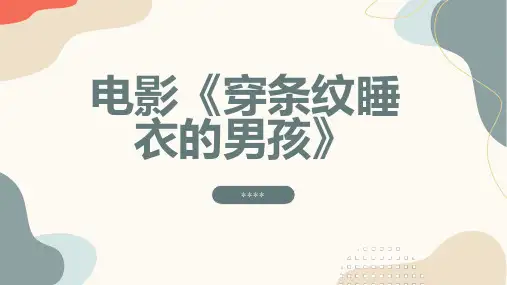
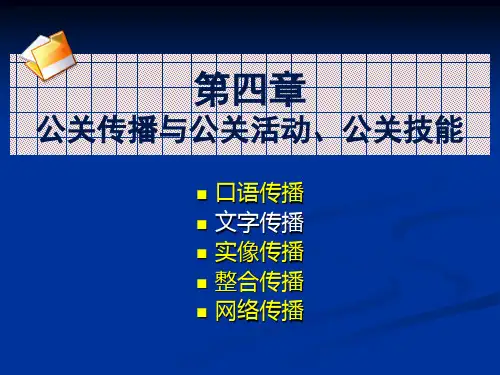
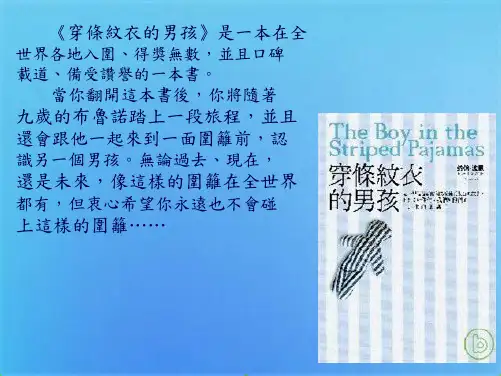
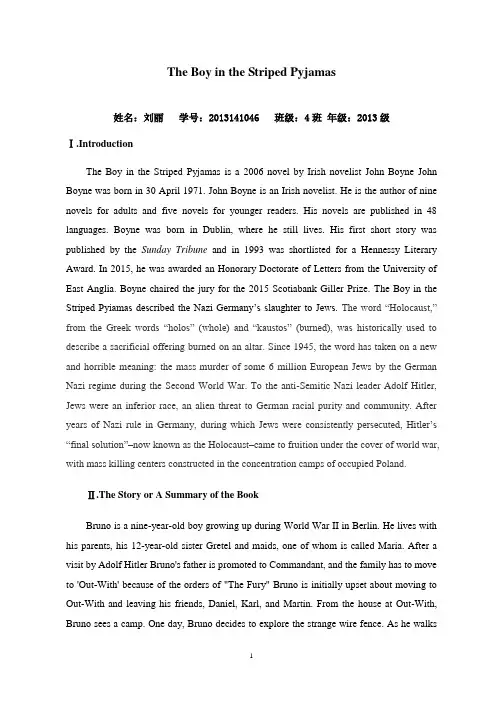
The Boy in the Striped Pyjamas姓名:刘丽学号:2013141046 班级:4班年级:2013级Ⅰ.IntroductionThe Boy in the Striped Pyjamas is a 2006 novel by Irish novelist John Boyne John Boyne was born in 30 April 1971. John Boyne is an Irish novelist. He is the author of nine novels for adults and five novels for younger readers. His novels are published in 48 languages. Boyne was born in Dublin, where he still lives. His first short story was published by the Sunday Tribune and in 1993 was shortlisted for a Hennessy Literary Award. In 2015, he was awarded an Honorary Doctorate of Letters from the University of East Anglia. Boyne chaired the jury for the 2015 Scotiabank Giller Prize. The Boy in the Striped Pyiamas described the Nazi Germany’s slaughter to Jews.The word “Holocaust,” from the Greek words “holos” (whole) and “kaustos” (burned), was historically used to describe a sacrificial offering burned on an altar. Since 1945, the word has taken on a new and horrible meaning: the mass murder of some 6 million European Jews by the German Nazi regime during the Second World War. To the anti-Semitic Nazi leader Adolf Hitler, Jews were an inferior race, an alien threat to German racial purity and community. After years of Nazi rule in Germany, during which Jews were consistently persecuted, Hitler’s “final solution”–now known as the Holocaust–came to fruition under the cover of world war, with mass killing centers constructed in the concentration camps of occupied Poland.Ⅱ.The Story or A Summary of the BookBruno is a nine-year-old boy growing up during World War II in Berlin. He lives with his parents, his 12-year-old sister Gretel and maids, one of whom is called Maria. After a visit by Adolf Hitler Bruno's father is promoted to Commandant, and the family has to move to 'Out-With' because of the orders of "The Fury" Bruno is initially upset about moving to Out-With and leaving his friends, Daniel, Karl, and Martin. From the house at Out-With, Bruno sees a camp. One day, Bruno decides to explore the strange wire fence. As he walksalong the fence, he meets a Jewish boy named Shmuel, whom he learns shares his birthday. Shmuel says that his father, grandfather, and brother are with him on this side of the fence, but he is separated from his mother. Bruno and Shmuel talk and become very good friends, although Bruno still does not understand very much about Shmuel and his side of the fence. As the meetings go on, Bruno's naïvete shows that his innocence has been preserved despite being near a death camp.When lice eggs are discovered in Bruno's hair he is forced to get all of his hair shaved off. Bruno comments that he looks like Shmuel, and Shmuel agrees, except that Bruno is fatter. Bruno's mother eventually persuades his father to take them back to Berlin and stay at Out-With without them.The next day Bruno concocts a plan with Shmuel to sneak into the camp to look for Shmuel's father. Shmuel brings a set of prison clothes, and Bruno leaves his own clothes outside the fence. As they search the camp, both children are rounded up along with a group of prisoners to be sent to the gas chamber. Bruno apologizes to Shmuel that they didn't successfully find his father, which Shmuel does not have a chance to reply to before the gas is turned on, and Shmuel and Bruno both die. Bruno's mother and sister return to Berlin, and his father stays at Out-With, where he finally works out what had happened. When soldiers come to take him away from Out-With, he is happy to be leaving.Ⅲ.Comments or My Views on the BookThe author’s style of writing is narration. This book uses a Germany child's vision to describe the tragedy of the Jews. Child’s world is very pure. They think the outside world should look like a fairy-tale like no lies and terror. So the prison clothes are regarded as pajamas under his imagination. The author expresses the horrible and cruel war and the pure of children. The war brings destructive strike not only to human but the aggressors. No matter when, no matter where, the children are the most innocent.。

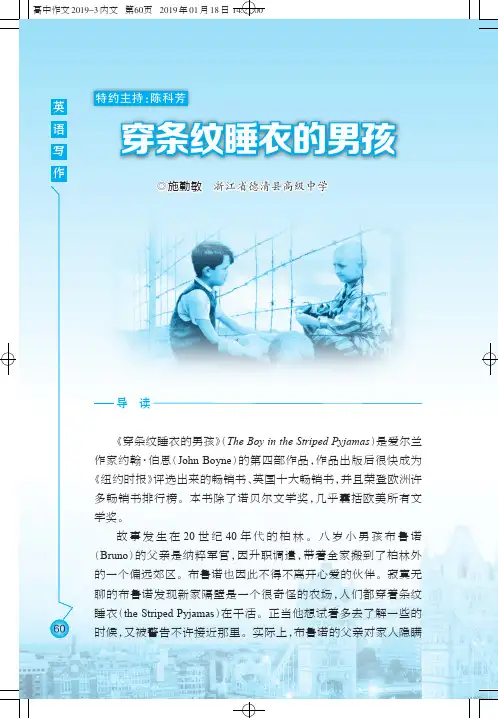
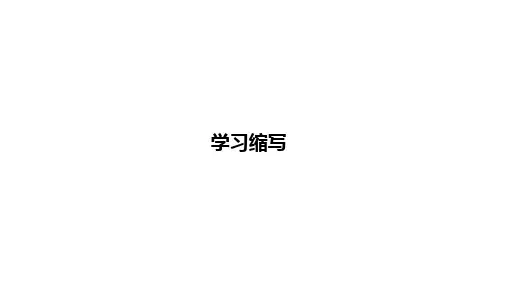
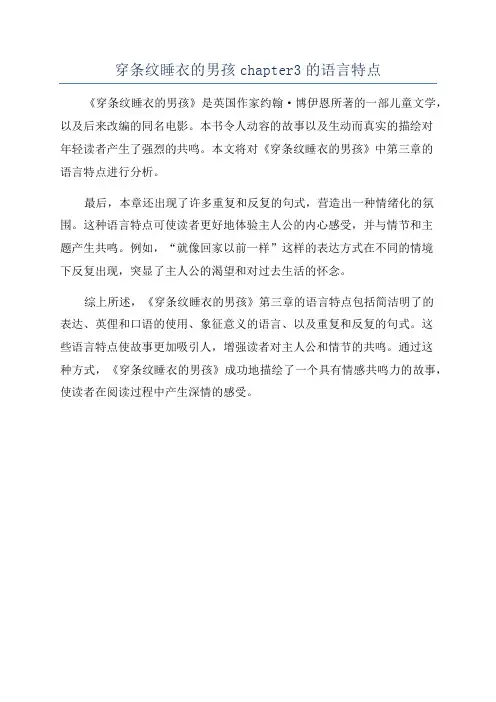
穿条纹睡衣的男孩chapter3的语言特点《穿条纹睡衣的男孩》是英国作家约翰·博伊恩所著的一部儿童文学,以及后来改编的同名电影。
本书令人动容的故事以及生动而真实的描绘对
年轻读者产生了强烈的共鸣。
本文将对《穿条纹睡衣的男孩》中第三章的
语言特点进行分析。
最后,本章还出现了许多重复和反复的句式,营造出一种情绪化的氛围。
这种语言特点可使读者更好地体验主人公的内心感受,并与情节和主
题产生共鸣。
例如,“就像回家以前一样”这样的表达方式在不同的情境
下反复出现,突显了主人公的渴望和对过去生活的怀念。
综上所述,《穿条纹睡衣的男孩》第三章的语言特点包括简洁明了的
表达、英俚和口语的使用、象征意义的语言、以及重复和反复的句式。
这
些语言特点使故事更加吸引人,增强读者对主人公和情节的共鸣。
通过这
种方式,《穿条纹睡衣的男孩》成功地描绘了一个具有情感共鸣力的故事,使读者在阅读过程中产生深情的感受。
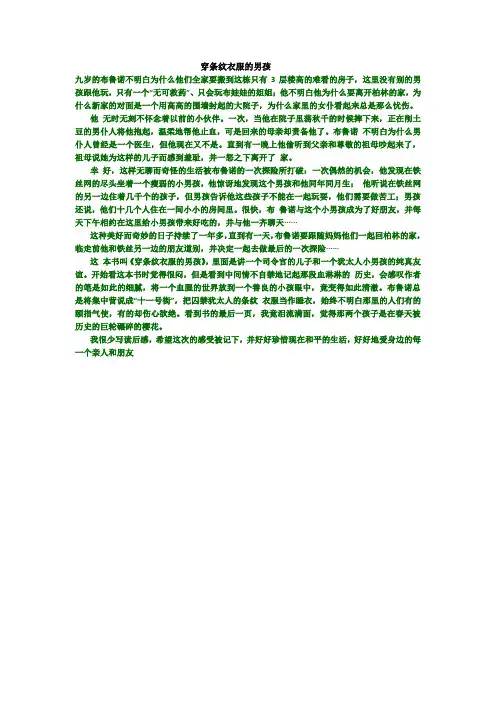
穿条纹衣服的男孩九岁的布鲁诺不明白为什么他们全家要搬到这栋只有3层楼高的难看的房子,这里没有别的男孩跟他玩,只有一个“无可救药”、只会玩布娃娃的姐姐;他不明白他为什么要离开柏林的家,为什么新家的对面是一个用高高的围墙封起的大院子,为什么家里的女仆看起来总是那么忧伤。
他无时无刻不怀念着以前的小伙伴。
一次,当他在院子里荡秋千的时候摔下来,正在削土豆的男仆人将他抱起,温柔地帮他止血,可是回来的母亲却责备他了。
布鲁诺不明白为什么男仆人曾经是一个医生,但他现在又不是。
直到有一晚上他偷听到父亲和尊敬的祖母吵起来了,祖母说她为这样的儿子而感到羞耻,并一怒之下离开了家。
幸好,这样无聊而奇怪的生活被布鲁诺的一次探险所打破:一次偶然的机会,他发现在铁丝网的尽头坐着一个瘦弱的小男孩,他惊讶地发现这个男孩和他同年同月生;他听说在铁丝网的另一边住着几千个的孩子,但男孩告诉他这些孩子不能在一起玩耍,他们需要做苦工;男孩还说,他们十几个人住在一间小小的房间里。
很快,布鲁诺与这个小男孩成为了好朋友,并每天下午相约在这里给小男孩带来好吃的,并与他一齐聊天······这种美好而奇妙的日子持续了一年多,直到有一天,布鲁诺要跟随妈妈他们一起回柏林的家,临走前他和铁丝另一边的朋友道别,并决定一起去做最后的一次探险······这本书叫《穿条纹衣服的男孩》,里面是讲一个司令官的儿子和一个犹太人小男孩的纯真友谊。
开始看这本书时觉得很闷,但是看到中间情不自禁地记起那段血淋淋的历史,会感叹作者的笔是如此的细腻,将一个血腥的世界放到一个善良的小孩眼中,竟变得如此清澈。
布鲁诺总是将集中营说成“十一号街”,把囚禁犹太人的条纹衣服当作睡衣,始终不明白那里的人们有的颐指气使,有的却伤心欲绝。
看到书的最后一页,我竟泪流满面,觉得那两个孩子是在春天被历史的巨轮碾碎的樱花。
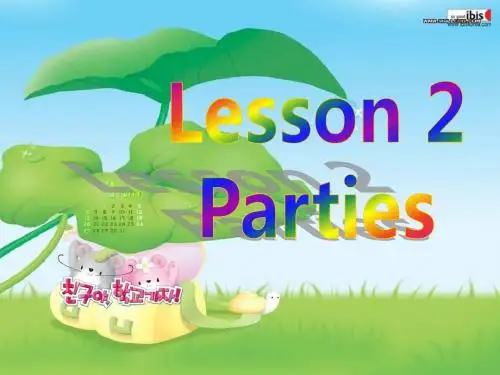
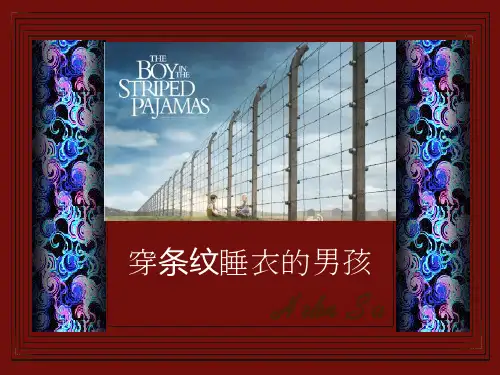
The Boy in the Striped PyjamasWeiThe Boy in the Striped Pyjamas is a novel by Irish novelist John Boyne. The story happened in German in 1942, during the World War II. Bruno, a nine-year-old boy, and his family have to leave their home in Berlin and move to a far and strange place where there is no other children to play with him. He then takes an exploration near the fence and meets a little boy who is on the other side of the fence, Shmuel. They become good friends and Bruno decides to help Shmuel to find his father, while he never comes out from the camp.Different from other war novels, this novel indirectly reveals the coldness and mercilessness of the war through two innocent little boys’talks, instead of describing the bloody and horrible scenes, evoking stronger feelings among readers and heartbreaking readers extremely. The innocence of children is in stark contrast with the cruelness and brutality of the war. When Bruno found the camp with the fence near their house, he simply regarded it as an ugly building. Hundreds of, even thousands of people in the same-look clothes, the striped clothes, lived in the camp and suffered great pains every day, but little Bruno did not know the truth and only felt happy when he found a lot of children were there. He told Shmuel he did not like striped clothes but in fact he liked it, of course he did not know what the clothes meant. He even felt unfair and admired Shmuel for Shmuel had a lot of friends to play with on the other side of the fence while he did not have. The war is so ridiculous and absurd in front of children’s innocent words, while children are poor and helpless in front of the war’s mercilessness.The war distorts people’s mind and makes adults’world full of deception and lies. Maria, the family’s maid, told Bruno his father was a very good man. He offered Maria a job and took care of Maria’s mother when she was very sick even though he was not obliged to. However, all these happened before the war. When Bruno’s father became an officer and got promoted, he changed. He told Bruno people in the striped clothes were not human beings and not allowed Bruno to look that camp from the window. He cheated that the terrible smell from the smokestack in the camp was the result of rubbish incineration. He looked for a teacher toteach Gretel and Bruno history and sociology, or exactly to implant Nazi concepts in them, which really worked, Gretel became tossed her doll aside and became interested in the Nazi concepts. People lost their nature during the war and became apathetic and cold.Even though people’s souls have been distorted and their personalities damaged, there are still people who are sane and rational. Bruno’s mother knew what her husband had done was inhuman and hoped to come back home in Berlin with their children. She argued with her husband, but she had no choice but to compromise with the reality because if she said something improper, the whole family would be in danger. Bruno’s grandmother was very clear with his father’s job and felt shameful for what his father had done. It is grateful that not everyone has lost their mind during the war. Although these people are also helpless in face of the war and can do nothing against the war, they bring us the hope of human nature.Regardless of the nationalities and races, we are all the same. In the end of the novel, Bruno put on the striped pyjamas and rolled under the fence, then they were on the same side of the fence. However, when Bruno wanted to went out and came back home, the soldiers called all the people in striped pyjamas be together and then he came into the gas chamber with Shmuel, but soldiers did not recognize him because they only knew the striped pyjamas. Even if you are the son of a Nazi officer, no one will know you if you wear the striped clothes - the symbol of Jewish. Thus, it is ridiculous to divide races, which Bruno’s death has proved.There is no winner in a war, especially the inhumane racial cleansing. The two little boys, Bruno and Shmuel, who have different destinies and fates were killed together in the gas chamber. Jewish suffered a lot from the second world war, while many innocent people also experienced a great pains, just like Bruno, a innocent and lovely little boy, becoming the victim of the war.。